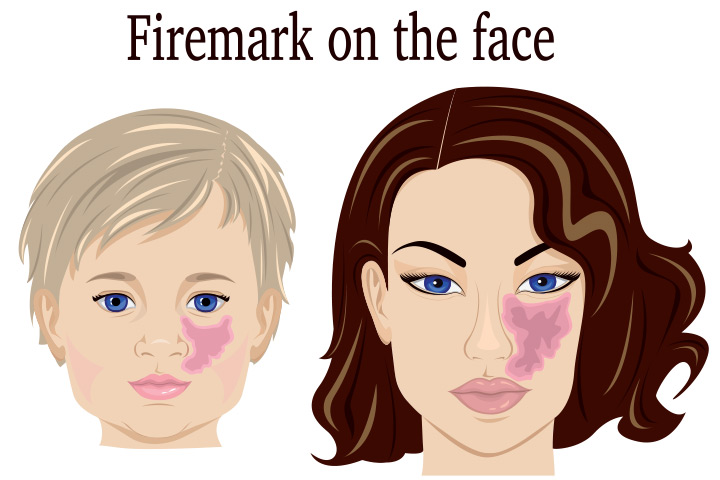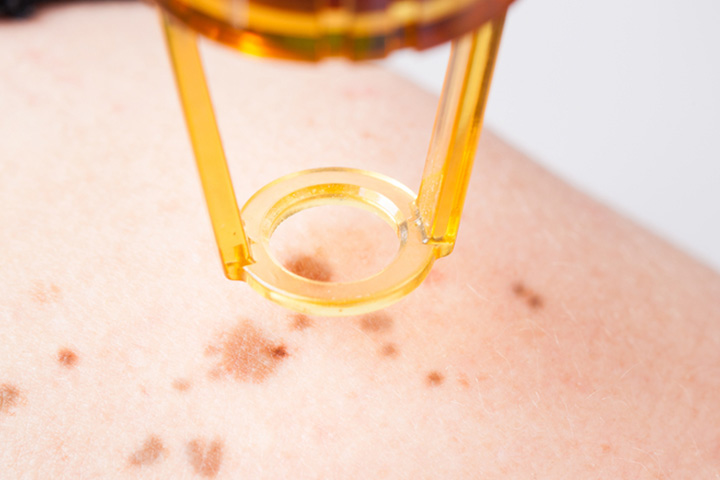
Image: Shutterstock
Birthmarks are congenital skin spots or marks already present from birth or appear within the first few months after birth. You may have noticed that birthmarks vary in shape, size, and color. They can occur anywhere on the skin.
Scientists are not sure why they occur. While some think it is hereditary, others link them to traditional beliefs, myths, and reincarnation theories.
Birthmarks are usually harmless for newborns. Mostly, they disappear with time, but some birthmarks last a lifetime.
There are two types of birthmarks:
- Pigmented birthmarks – caused by excess pigment cells
- Vascular birthmarks – caused by increased blood vessels
Pigmented Birthmarks
These are the common pigmented birthmarks:
1. Moles
Moles usually appear as small, flat, and round marks on the skin. They could be irregular or lump-like. They don’t appear until the child is one year old or more. Only 1 % of babies have moles right from birth.
You don’t need to worry about moles unless your baby has an itchy, irregular mole which is unusually large. If so, get your baby examined by a dermatologist.
2. Mongolian spots
Mongolian Spots are caused by abnormal pigment cells. These birthmarks are bluish or gray in color. Mostly, they occur at the lower back or near the buttocks.
They aren’t dangerous. In most cases, these spots fade away by the time your baby is around four years old.
3. Café au lait spots
This name is borrowed from French in which it means ‘coffee with milk’. These birthmarks are smooth, irregular, and light or dark brown patches on the skin.
These birthmarks are harmless. They don’t disappear with time. But, if you spot four or five such light-colored patches on the skin, it could be a sign of neurofibromatosis—a genetic disorder associated with tumors of nerve tissues. In such a case, get your child examined by your doctor at the earliest.
Vascular Birthmarks
These are the common vascular birthmarks:
1. Port-wine stains
These birthmarks appear like red wine spilled on the face and hence the name! However, the birthmarks can occur anywhere. They can be tiny, millimeter-wide marks or even a few centimeters long.
Though these aren’t eye-pleasing, you must realize that these birthmarks will not fade away and may darken or thicken over a period of time. If desired, you should treat these birthmarks with laser treatment once the child grows up (1).
2. Salmon patches
Salmon patches are called ‘angel’s kiss’ if they appear on the face and ‘stork’s bite’ if they occur at the back of the neck. Unlike port-wine stains, salmon patches don’t grow larger or darker with time.
3. Hemangioma
These birthmarks are called ‘strawberry marks’. These marks are not pleasing to the eye. They appear about two weeks after birth. These marks grow between six and nine months of age. However, they are usually harmless. Mostly, these marks fade away around three to ten years of age.
However, if the birthmark area is bleeding, you should apply an antibacterial ointment and wet compresses. In some cases, that area maybe painful. In such a case, get your kid examined by a dermatologist.
Should You Remove Or Treat Birthmarks?
Most birthmarks are harmless and fade away with time. However, your pediatrician or dermatologist may give you the best answer.
If the birthmarks cause physical problems, pain, or bleeding, it’s better to get your child examined by a dermatologist. Common treatment methods are laser treatment, steroids, and surgery.
If the birthmark is unpleasant to look at and doesn’t cause any medical issues, talk to your kid about it. Tell your child that it’s just a birthmark, which is completely natural.
Talk to your pediatrician or dermatologist to discuss whether treatment should be provided or the birthmark should be left as is.
















